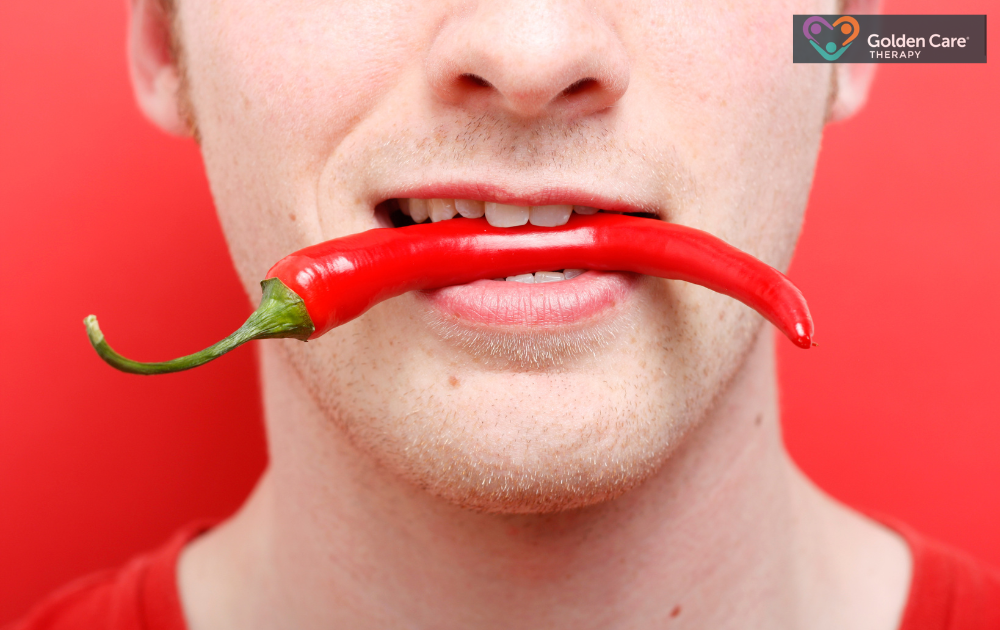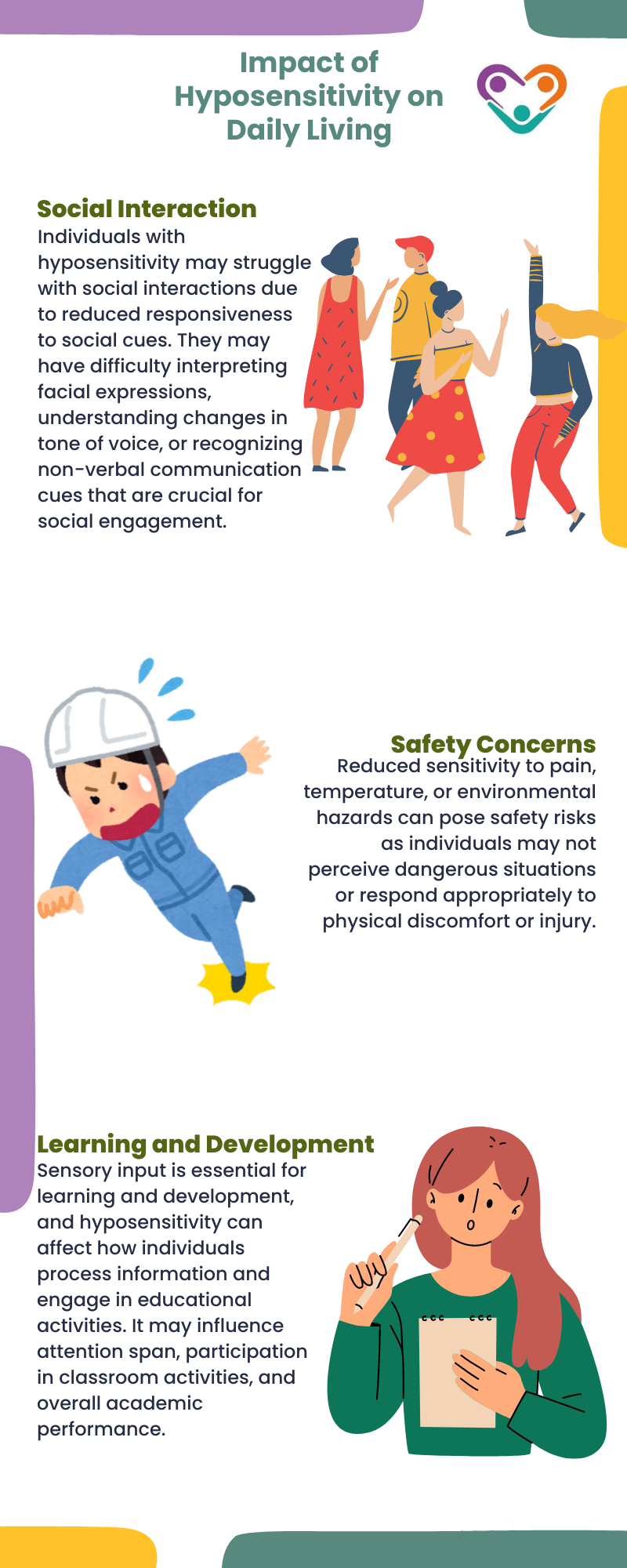Hyposensitivity, also referred to as sensory underresponsivity or sensory seeking behavior, is a distinctive sensory processing pattern frequently observed in individuals with autism spectrum disorder (ASD). It describes a reduced sensitivity or diminished responsiveness to sensory stimuli compared to neurotypical individuals.
This condition can affect various sensory modalities, including touch, taste, smell, sight, sound, and proprioception (awareness of body position). Let’s look at this condition in further detail.

What is Hyposensitivity in Autism?
Hyposensitivity in autism, also known as under-responsiveness, refers to a decreased sensitivity to sensory stimuli. Individuals with hyposensitivity may not respond to sensory inputs that others find noticeable or even overwhelming. This can manifest in various ways, such as not reacting to loud noises, bright lights, or physical pain. For example, a child with hyposensitivity might not notice when their name is called, might seek out intense sensory experiences like spinning or crashing into things, or might have a high pain tolerance.
This sensory processing difference is due to the brain’s unique way of interpreting and responding to sensory information.
Living with hyposensitivity can significantly impact daily life. People with this condition often engage in behaviors that provide the sensory input they crave, which can sometimes be misunderstood as disruptive or inappropriate. For instance, a child might flap their hands, rock back and forth, or chew on objects to self-stimulate and fulfill their sensory needs. Understanding hyposensitivity is crucial for caregivers and educators, as it allows them to create supportive environments that accommodate these sensory differences. By providing appropriate sensory activities and tools, such as weighted blankets or sensory-friendly toys, they can help individuals with hyposensitivity navigate their world more comfortably and effectively.
Sensory processing involves how the nervous system receives and interprets sensory information from the environment.
For individuals with autism, sensory processing differences are prevalent and can vary widely. Hyposensitivity is characterized by a reduced sensitivity to sensory inputs, leading to less intense or delayed responses to stimuli that typically evoke stronger reactions in neurotypical individuals. This variability in sensory processing contributes significantly to the diverse sensory profiles seen in autism.

Types of Hyposensitivity
There are several types of hyposensitivity that have been observed among autistic individuals. They’re as follows:
Tactile Hyposensitivity
Individuals with tactile hyposensitivity may demonstrate reduced sensitivity to touch sensations. They might seek out deep-pressure activities such as squeezing or pushing against objects to feel sensory input more intensely. Certain textures that might feel uncomfortable or irritating to others could be soothing or unnoticed by those with tactile hyposensitivity.
Auditory Hyposensitivity
This type involves reduced sensitivity to sound. Individuals may not react to loud noises or may seek out loud sounds for sensory stimulation. Common noises that are bothersome to neurotypical individuals, such as sirens or alarms, might not elicit a response or discomfort in someone with auditory hyposensitivity.

Visual Hyposensitivity
Reduced sensitivity to visual stimuli means individuals may not notice subtle changes in their environment or may not respond to visual cues that others find significant. This can affect tasks requiring visual attention or detail-oriented activities where noticing fine distinctions is crucial.
Olfactory and Gustatory Hyposensitivity
Smell and taste sensitivities can also be affected, leading to reduced awareness or interest in certain smells or flavors. Some individuals may seek out strong or unusual smells and tastes to achieve sensory satisfaction.
Proprioceptive and Vestibular Hyposensitivity
Proprioception involves awareness of body position and movement, while the vestibular sense relates to balance and spatial orientation. Hyposensitivity in these areas may result in seeking out intense movement or pressure to feel grounded or balanced, or it may lead to challenges in maintaining balance and coordination.
Impact on Daily Life
Hyposensitivity can significantly impact daily life across various domains. Here are some of them:

Management and Interventions
Managing hyposensitivity in autism involves creating a supportive environment that addresses sensory needs. There are a bunch of interventions that parents and caregivers can turn to.
One excellent example is sensory integration therapy. This therapeutic approach aims to improve sensory processing through structured activities that gradually expose individuals to sensory stimuli. It focuses on helping individuals regulate their responses to sensory input and integrate sensory information more effectively.
Adjusting sensory input in home, school, or work environments can also help reduce sensory overload or provide necessary stimulation based on individual sensory profiles. This may include controlling lighting, noise levels, and tactile stimuli to create a more comfortable and conducive environment.
Lastly, occupational therapists play a critical role in developing personalized sensory strategies and coping mechanisms. They work closely with individuals and families to identify specific sensory challenges and implement strategies that promote functional skills and independence in daily activities.
Research and Studies
Research into hyposensitivity in autism continues to expand our understanding of sensory processing differences and their implications:
Research studies highlight the complexity of sensory processing patterns in autism. These studies emphasize the variability in sensory profiles among individuals with ASD, including both hyposensitive and hypersensitive responses across different sensory domains.
Neuroscientific investigations suggest that sensory processing differences in autism may be linked to atypical neural processing and connectivity in sensory pathways. These findings underscore the need for personalized approaches to sensory interventions that take into account individual sensory profiles and neurological differences.
Final Thoughts
Hyposensitivity in autism represents a significant aspect of sensory processing differences where individuals may exhibit reduced sensitivity or responsiveness to sensory stimuli across multiple modalities. This condition impacts various aspects of daily life, including social interactions, safety, and learning experiences.
Effective management strategies involve tailored interventions such as sensory integration therapy, environmental modifications, and occupational therapy to support individuals in navigating their sensory environments more effectively.
Ongoing research plays a crucial role in advancing our understanding of sensory processing in autism and improving interventions that enhance the quality of life for individuals on the spectrum. If you’re seeking specialized support, consider the ABA centers in New Jersey, New York, Georgia, and Indiana offered by Golden Care. Contact us today or book an appointment to learn more about how we can assist you or your loved one.
Sources:
https://www.autismparentingmagazine.com/hyposensitivity-among-autistic-individuals
https://www.webmd.com/brain/autism/what-is-hyposensitivity
https://www.sciencedirect.com/topics/psychology/hyposensitivity



